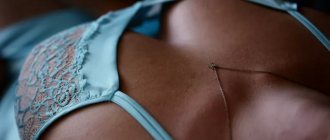Rehabilitation after breast correction involves some restrictions, which are gradually removed during 6 months of recovery, so every woman should know what not to do after mammoplasty. After all, the flawless and desired result of aesthetic surgery is a joint work of the plastic surgeon and the patient. It is extremely important to strictly follow all the doctor’s recommendations and consult with him on basic issues: when, after breast augmentation, can you remove the compression underwear and replace it with a new beautiful bra with underwire? What medications should I take? How to care for your skin and when can you resume sports? Unfortunately, there are no unambiguous and generalized answers to these questions, since the course of rehabilitation is extremely individual. Specialists of the clinic named after. N.I. Pirogov is always in touch and guides her patients from the moment of initial consultation until the successful completion of rehabilitation.
Clinical picture and diagnosis
Most often, a hematoma forms in one mammary gland, due to which visible asymmetry develops. Soft tissues become painful when pressed and feel hot to the touch. The skin over the hematoma may change in color, but may remain normal. Other nonspecific symptoms include weakness, malaise, and decreased performance.
To identify a hematoma, as a rule, it is enough to analyze the patient’s clinical manifestations and complaints, as well as perform an ultrasound of the mammary glands and a general blood test.
In some cases, the surgeon may prescribe additional diagnostic methods.
First week after surgery:
All you need to do is rest. It should be understood that the metabolic rate increases after surgery, so even during complete rest, the extra calories that worry most women will “burn” many times faster. To relieve any possible pain or discomfort after surgery, your doctor may recommend lightly stretching your muscles without resorting to even mild exercise. In general, walking in the fresh air is always beneficial. But even if pain or discomfort occurs, they should be canceled.
How long does it take for swelling to subside after breast augmentation?
This is determined by the individual characteristics of the organism, but the average statistical time is indicated as a guide. The increase in swelling is completed by the end of 4 days. Then the condition of the tissues begins to improve.
Visible signs of stagnation of lymph and intercellular fluid persist from 2 to 4 weeks. Internal swelling after breast augmentation lasts longer - up to 3 months.
Slow restoration of lymph flow is normal and does not require correction in the absence of fever, changes in skin color and the appearance of new lumps.
Over the course of six months, the mammary glands will change shape. But it will be possible to evaluate the primary result of the operation when the lymph flow is restored.
Treatment
The only effective treatment for hematoma is surgery. Its essence is to remove the blood, search for a bleeding vessel and then cauterize it, rinse the pocket with the implant and install drains. Drains must be installed for a period of at least 5 days. Despite the fact that surgical treatment is the only possible method of eliminating a hematoma, in some cases conservative therapy can also be used. As a rule, it is prescribed in the early postoperative period when the first signs of complications appear.
The goal of conservative treatment is to stop or reduce the intensity of bleeding from a damaged vessel and prevent the hematoma from increasing in size. To do this, take a horizontal position and apply cold. If the development of a hematoma did not occur against the background of high blood pressure, then antihypertensive therapy may be effective. In case of low blood clotting, drugs are prescribed that increase it. All these measures are not an alternative to surgical treatment, so the operation is performed in any case.
Benefits of plastic surgery after breastfeeding
At the end of feeding, the following changes may occur in the mammary glands:
- areola stretching;
- nipple deformation;
- drooping bust;
- asymmetry
There is an opinion that refusing to breastfeed can preserve a beautiful bust in its pre-pregnancy state. However, this is not true. Regardless of whether the expectant mother will breastfeed the baby or not, changes in the mammary glands begin during pregnancy, long before childbirth. However, there are also cases when nursing mothers’ breasts do not lose their attractiveness at all, but such cases are quite rare.
A professional surgeon can easily restore the prenatal appearance of the bust, and often even help to surpass it. Mammoplasty can solve many problems, including those that existed before pregnancy.
Seroma
A seroma is a cavity filled with fluid. The more extensive the breast surgery, the higher the risk of its occurrence. It appears as a lump, the area of which may be painful. If an infection penetrates into the seroma, redness, swelling, severe pain occurs, and body temperature rises.
What to do? Small seromas may not be treated. If the cavity is large enough, the doctor can perform a puncture: insert a needle and remove the fluid. If after repeated punctures the seroma recurs, the question of surgical intervention arises.
Make an appointment with a surgeon-mammologist
Causes
Hematoma is usually a complication of the early postoperative period and is due to the following reasons:
- Insufficient vascular hemostasis. Any surgical intervention is accompanied by vascular damage. Regardless of their diameter, the surgeon must perform careful hemostasis.
- A sharp increase in blood pressure. Normally, the damaged vessel is blocked by a blood clot, which prevents further bleeding. With a sharp rise in pressure, this blood clot “breaks”.
- The patient has comorbidities, such as a bleeding disorder.
- The size of the implant does not match the size of the pocket that is formed before its installation.
- Violation of the rules of conduct during the rehabilitation period - severe physical activity, chest injury, refusal to use compression garments.
A hematoma is dangerous because when it occurs, the risk of developing another pathology increases: infections, capsular contracture, etc. That is why both the surgeon and the patient must make every effort to avoid this complication.
Results of the experiment of Brazilian surgeons
According to the authors of the study, their data confirmed the safety of sports in the early rehabilitation period. Moreover, they were able to establish that in the “sports” group the overall complication rate was 6.9%, and in the non-exercise group it was 7.5%. The authors note that these complications were mild, and no patient required reoperation throughout the year. In addition, Brazilian surgeons note that the quality of scars in the groups is comparable.
Another parameter measured by the authors of the experiment was the level of satisfaction with the results of the operation. Surprisingly, patients who exercised were more satisfied with the results of mammoplasty. On a 100-point scale of the BREAST-Q questionnaire, their average satisfaction score is 83, while in the control group it does not exceed 66.
These results are puzzling, to say the least, for plastic surgeons who advise their patients to postpone exercise during recovery. On the one hand, early postoperative exercises may be useful, on the other hand, it must be remembered that in the framework of this experiment, sports were carried out UNDER THE CONTROL OF DOCTORS!










